Yitian Zhang
Stephen
MTS-DMAE: Dual-Masked Autoencoder for Unsupervised Multivariate Time Series Representation Learning
Sep 19, 2025
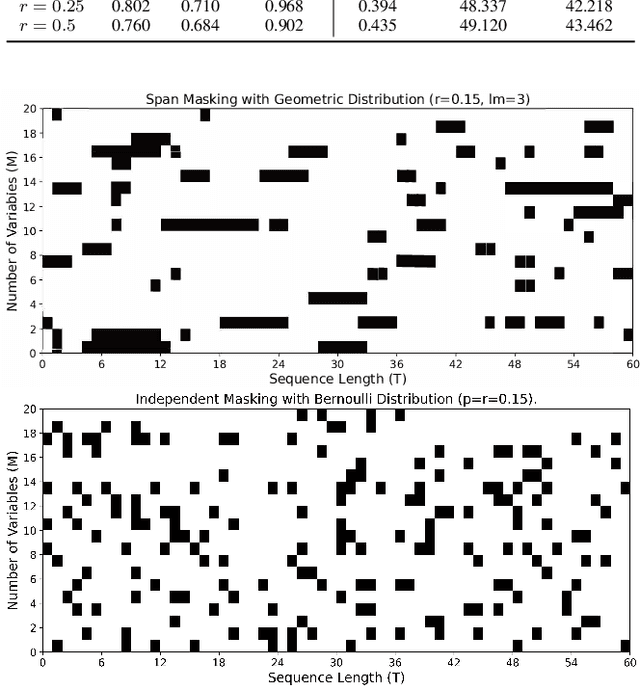
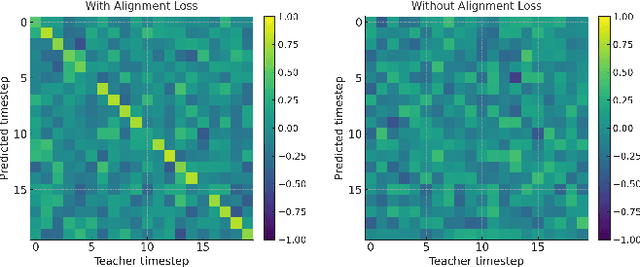
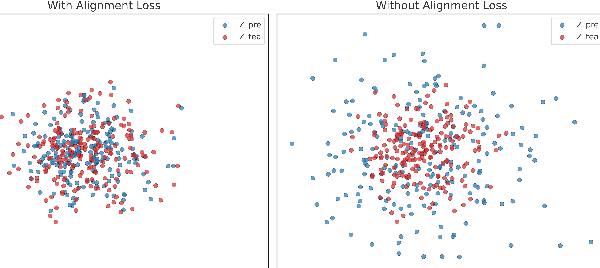
Abstract:Unsupervised multivariate time series (MTS) representation learning aims to extract compact and informative representations from raw sequences without relying on labels, enabling efficient transfer to diverse downstream tasks. In this paper, we propose Dual-Masked Autoencoder (DMAE), a novel masked time-series modeling framework for unsupervised MTS representation learning. DMAE formulates two complementary pretext tasks: (1) reconstructing masked values based on visible attributes, and (2) estimating latent representations of masked features, guided by a teacher encoder. To further improve representation quality, we introduce a feature-level alignment constraint that encourages the predicted latent representations to align with the teacher's outputs. By jointly optimizing these objectives, DMAE learns temporally coherent and semantically rich representations. Comprehensive evaluations across classification, regression, and forecasting tasks demonstrate that our approach achieves consistent and superior performance over competitive baselines.
SKOLR: Structured Koopman Operator Linear RNN for Time-Series Forecasting
Jun 17, 2025Abstract:Koopman operator theory provides a framework for nonlinear dynamical system analysis and time-series forecasting by mapping dynamics to a space of real-valued measurement functions, enabling a linear operator representation. Despite the advantage of linearity, the operator is generally infinite-dimensional. Therefore, the objective is to learn measurement functions that yield a tractable finite-dimensional Koopman operator approximation. In this work, we establish a connection between Koopman operator approximation and linear Recurrent Neural Networks (RNNs), which have recently demonstrated remarkable success in sequence modeling. We show that by considering an extended state consisting of lagged observations, we can establish an equivalence between a structured Koopman operator and linear RNN updates. Building on this connection, we present SKOLR, which integrates a learnable spectral decomposition of the input signal with a multilayer perceptron (MLP) as the measurement functions and implements a structured Koopman operator via a highly parallel linear RNN stack. Numerical experiments on various forecasting benchmarks and dynamical systems show that this streamlined, Koopman-theory-based design delivers exceptional performance.
S-Crescendo: A Nested Transformer Weaving Framework for Scalable Nonlinear System in S-Domain Representation
May 17, 2025Abstract:Simulation of high-order nonlinear system requires extensive computational resources, especially in modern VLSI backend design where bifurcation-induced instability and chaos-like transient behaviors pose challenges. We present S-Crescendo - a nested transformer weaving framework that synergizes S-domain with neural operators for scalable time-domain prediction in high-order nonlinear networks, alleviating the computational bottlenecks of conventional solvers via Newton-Raphson method. By leveraging the partial-fraction decomposition of an n-th order transfer function into first-order modal terms with repeated poles and residues, our method bypasses the conventional Jacobian matrix-based iterations and efficiently reduces computational complexity from cubic $O(n^3)$ to linear $O(n)$.The proposed architecture seamlessly integrates an S-domain encoder with an attention-based correction operator to simultaneously isolate dominant response and adaptively capture higher-order non-linearities. Validated on order-1 to order-10 networks, our method achieves up to 0.99 test-set ($R^2$) accuracy against HSPICE golden waveforms and accelerates simulation by up to 18(X), providing a scalable, physics-aware framework for high-dimensional nonlinear modeling.
Fusing Global and Local: Transformer-CNN Synergy for Next-Gen Current Estimation
Apr 08, 2025Abstract:This paper presents a hybrid model combining Transformer and CNN for predicting the current waveform in signal lines. Unlike traditional approaches such as current source models, driver linear representations, waveform functional fitting, or equivalent load capacitance methods, our model does not rely on fixed simplified models of standard-cell drivers or RC loads. Instead, it replaces the complex Newton iteration process used in traditional SPICE simulations, leveraging the powerful sequence modeling capabilities of the Transformer framework to directly predict current responses without iterative solving steps. The hybrid architecture effectively integrates the global feature-capturing ability of Transformers with the local feature extraction advantages of CNNs, significantly improving the accuracy of current waveform predictions. Experimental results demonstrate that, compared to traditional SPICE simulations, the proposed algorithm achieves an error of only 0.0098. These results highlight the algorithm's superior capabilities in predicting signal line current waveforms, timing analysis, and power evaluation, making it suitable for a wide range of technology nodes, from 40nm to 3nm.
GmNet: Revisiting Gating Mechanisms From A Frequency View
Mar 28, 2025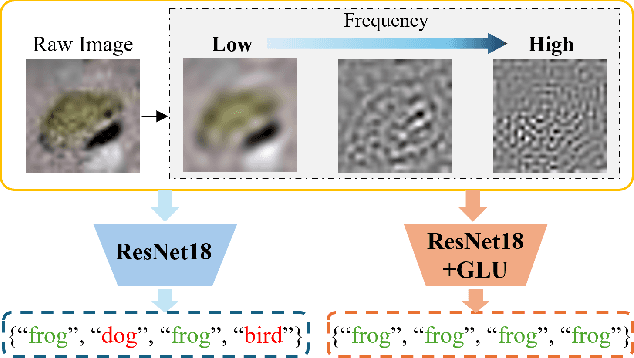

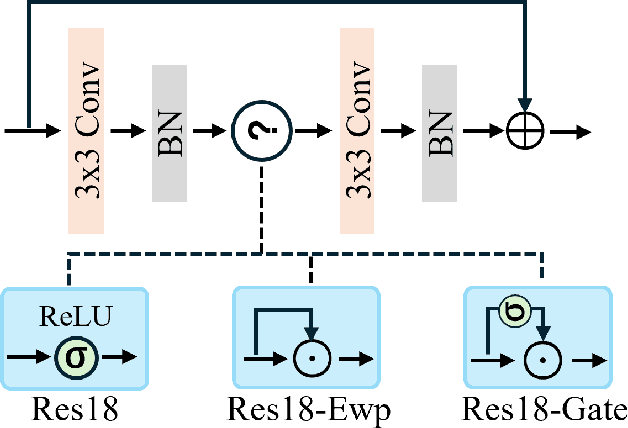
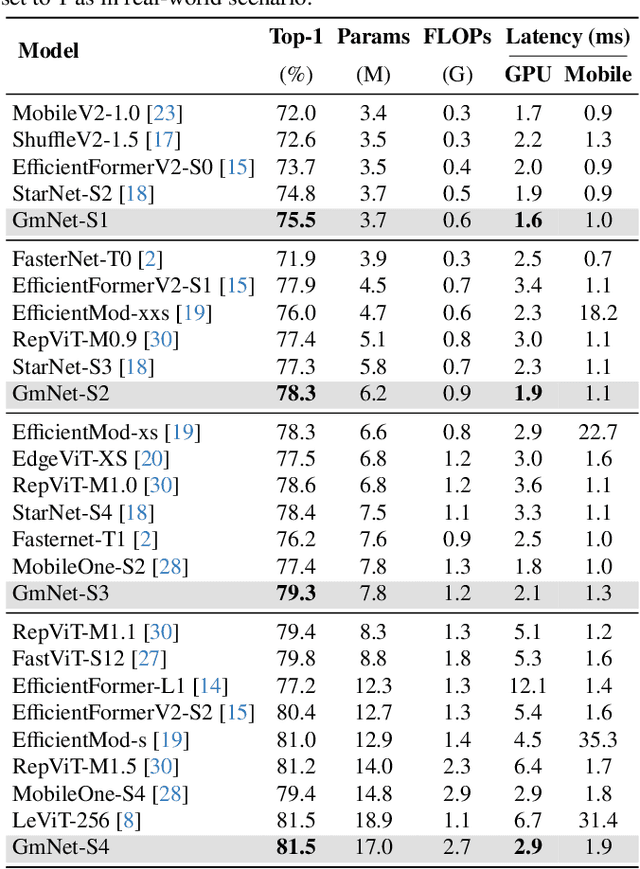
Abstract:Gating mechanisms have emerged as an effective strategy integrated into model designs beyond recurrent neural networks for addressing long-range dependency problems. In a broad understanding, it provides adaptive control over the information flow while maintaining computational efficiency. However, there is a lack of theoretical analysis on how the gating mechanism works in neural networks. In this paper, inspired by the {convolution theorem}, we systematically explore the effect of gating mechanisms on the training dynamics of neural networks from a frequency perspective. We investigate the interact between the element-wise product and activation functions in managing the responses to different frequency components. Leveraging these insights, we propose a Gating Mechanism Network (GmNet), a lightweight model designed to efficiently utilize the information of various frequency components. It minimizes the low-frequency bias present in existing lightweight models. GmNet achieves impressive performance in terms of both effectiveness and efficiency in the image classification task.
REGEN: Learning Compact Video Embedding with (Re-)Generative Decoder
Mar 11, 2025


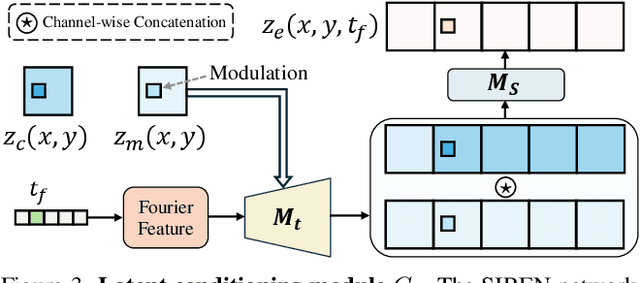
Abstract:We present a novel perspective on learning video embedders for generative modeling: rather than requiring an exact reproduction of an input video, an effective embedder should focus on synthesizing visually plausible reconstructions. This relaxed criterion enables substantial improvements in compression ratios without compromising the quality of downstream generative models. Specifically, we propose replacing the conventional encoder-decoder video embedder with an encoder-generator framework that employs a diffusion transformer (DiT) to synthesize missing details from a compact latent space. Therein, we develop a dedicated latent conditioning module to condition the DiT decoder on the encoded video latent embedding. Our experiments demonstrate that our approach enables superior encoding-decoding performance compared to state-of-the-art methods, particularly as the compression ratio increases. To demonstrate the efficacy of our approach, we report results from our video embedders achieving a temporal compression ratio of up to 32x (8x higher than leading video embedders) and validate the robustness of this ultra-compact latent space for text-to-video generation, providing a significant efficiency boost in latent diffusion model training and inference.
Scale-Free Graph-Language Models
Feb 21, 2025Abstract:Graph-language models (GLMs) have demonstrated great potential in graph-based semi-supervised learning. A typical GLM consists of two key stages: graph generation and text embedding, which are usually implemented by inferring a latent graph and finetuning a language model (LM), respectively. However, the former often relies on artificial assumptions about the underlying edge distribution, while the latter requires extensive data annotations. To tackle these challenges, this paper introduces a novel GLM that integrates graph generation and text embedding within a unified framework. Specifically, for graph generation, we leverage an inherent characteristic of real edge distribution--the scale-free property--as a structural prior. We unexpectedly find that this natural property can be effectively approximated by a simple k-nearest neighbor (KNN) graph. For text embedding, we develop a graph-based pseudo-labeler that utilizes scale-free graphs to provide complementary supervision for improved LM finetuning. Extensive experiments on representative datasets validate our findings on the scale-free structural approximation of KNN graphs and demonstrate the effectiveness of integrating graph generation and text embedding with a real structural prior. Our code is available at https://github.com/Jianglin954/SFGL.
Progressive Growing of Video Tokenizers for Highly Compressed Latent Spaces
Jan 09, 2025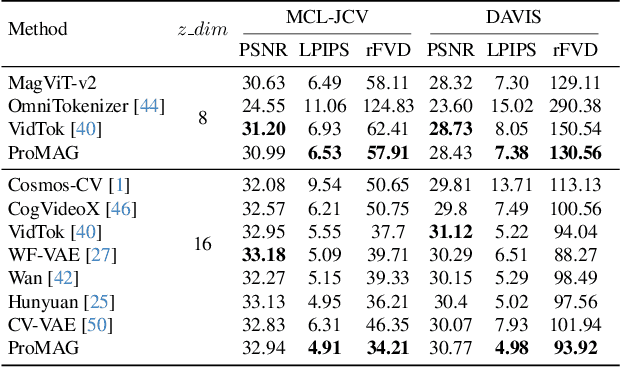
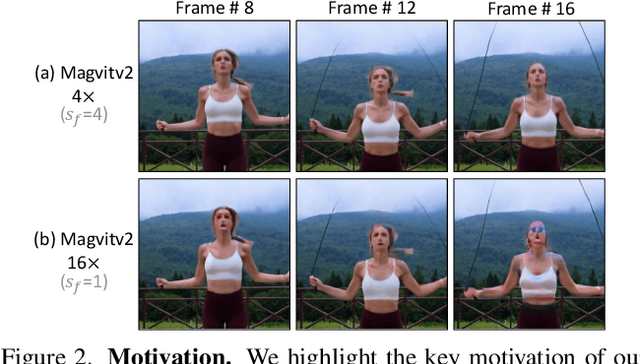
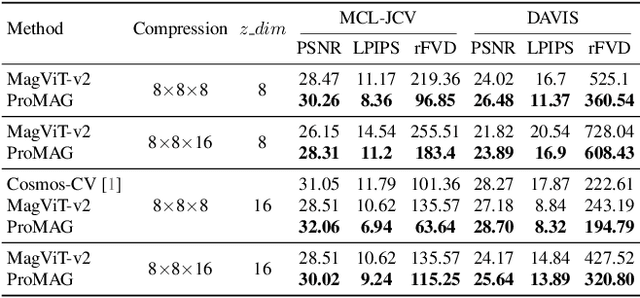
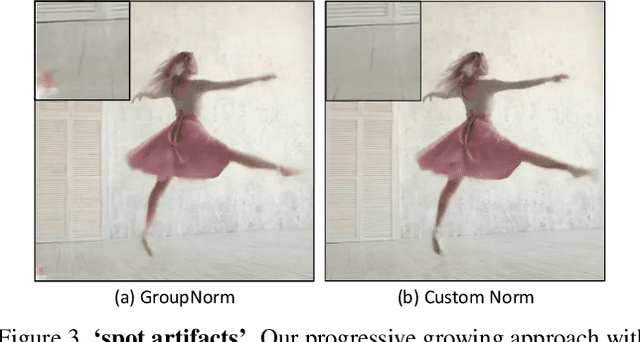
Abstract:Video tokenizers are essential for latent video diffusion models, converting raw video data into spatiotemporally compressed latent spaces for efficient training. However, extending state-of-the-art video tokenizers to achieve a temporal compression ratio beyond 4x without increasing channel capacity poses significant challenges. In this work, we propose an alternative approach to enhance temporal compression. We find that the reconstruction quality of temporally subsampled videos from a low-compression encoder surpasses that of high-compression encoders applied to original videos. This indicates that high-compression models can leverage representations from lower-compression models. Building on this insight, we develop a bootstrapped high-temporal-compression model that progressively trains high-compression blocks atop well-trained lower-compression models. Our method includes a cross-level feature-mixing module to retain information from the pretrained low-compression model and guide higher-compression blocks to capture the remaining details from the full video sequence. Evaluation of video benchmarks shows that our method significantly improves reconstruction quality while increasing temporal compression compared to direct extensions of existing video tokenizers. Furthermore, the resulting compact latent space effectively trains a video diffusion model for high-quality video generation with a reduced token budget.
Slicing Vision Transformer for Flexible Inference
Dec 06, 2024Abstract:Vision Transformers (ViT) is known for its scalability. In this work, we target to scale down a ViT to fit in an environment with dynamic-changing resource constraints. We observe that smaller ViTs are intrinsically the sub-networks of a larger ViT with different widths. Thus, we propose a general framework, named Scala, to enable a single network to represent multiple smaller ViTs with flexible inference capability, which aligns with the inherent design of ViT to vary from widths. Concretely, Scala activates several subnets during training, introduces Isolated Activation to disentangle the smallest sub-network from other subnets, and leverages Scale Coordination to ensure each sub-network receives simplified, steady, and accurate learning objectives. Comprehensive empirical validations on different tasks demonstrate that with only one-shot training, Scala learns slimmable representation without modifying the original ViT structure and matches the performance of Separate Training. Compared with the prior art, Scala achieves an average improvement of 1.6% on ImageNet-1K with fewer parameters.
SFDFusion: An Efficient Spatial-Frequency Domain Fusion Network for Infrared and Visible Image Fusion
Oct 30, 2024
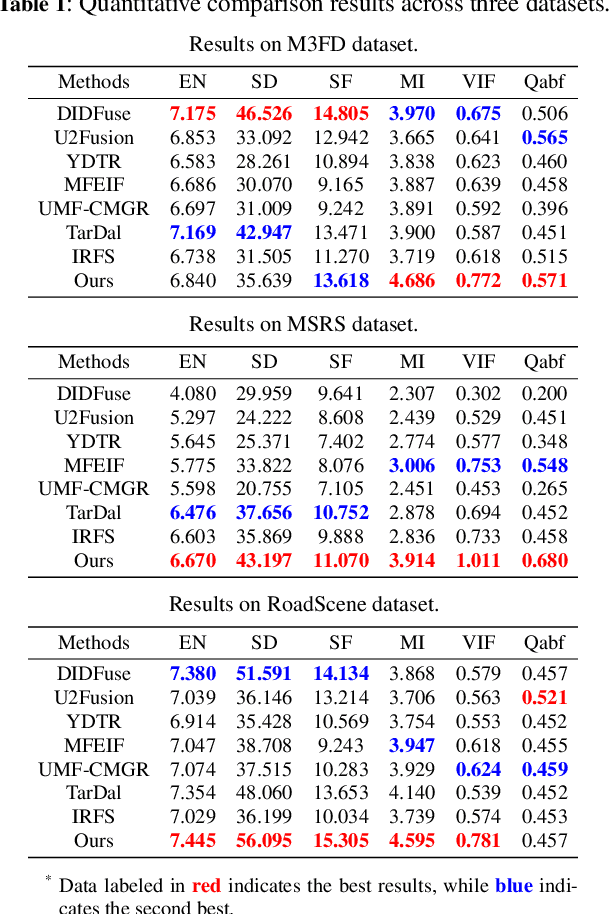

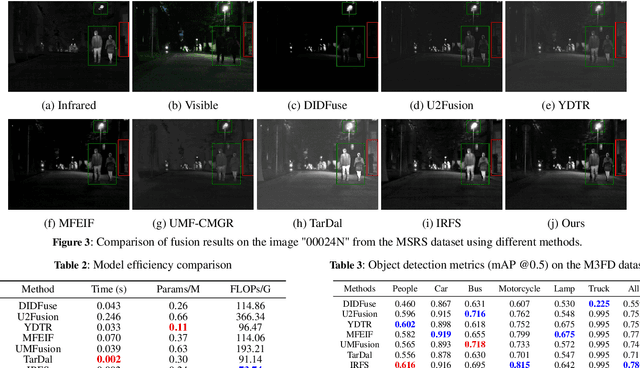
Abstract:Infrared and visible image fusion aims to utilize the complementary information from two modalities to generate fused images with prominent targets and rich texture details. Most existing algorithms only perform pixel-level or feature-level fusion from different modalities in the spatial domain. They usually overlook the information in the frequency domain, and some of them suffer from inefficiency due to excessively complex structures. To tackle these challenges, this paper proposes an efficient Spatial-Frequency Domain Fusion (SFDFusion) network for infrared and visible image fusion. First, we propose a Dual-Modality Refinement Module (DMRM) to extract complementary information. This module extracts useful information from both the infrared and visible modalities in the spatial domain and enhances fine-grained spatial details. Next, to introduce frequency domain information, we construct a Frequency Domain Fusion Module (FDFM) that transforms the spatial domain to the frequency domain through Fast Fourier Transform (FFT) and then integrates frequency domain information. Additionally, we design a frequency domain fusion loss to provide guidance for the fusion process. Extensive experiments on public datasets demonstrate that our method produces fused images with significant advantages in various fusion metrics and visual effects. Furthermore, our method demonstrates high efficiency in image fusion and good performance on downstream detection tasks, thereby satisfying the real-time demands of advanced visual tasks.
 Add to Chrome
Add to Chrome Add to Firefox
Add to Firefox Add to Edge
Add to Edge